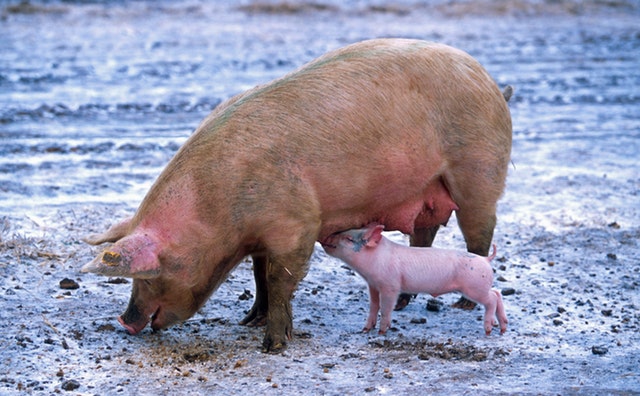The reproduction of pigs is of great economic importance to man because the consumption of pork is widespread throughout the world. However, many new pig breeders embark on pig production without having the basic knowledge about pig gestation. In this article, an overview of pig gestation and reproduction are discussed.
Reproductive Characteristics of Sows
Reproduction is an essential aspect in animal exploitation, since it is this that allows us the productivity of the species. In the pig herds, the reproductive behavior has a high economic importance, well known, in such a way that the studies that analyze the factors that affect the integral traits of it are essential, in order to increase the productivity of the sow.
- Sows are fixed polyester animals, that is, their jealousy is regular throughout the year.
- The length of the estrous cycle varies depending on factors such as the sow’s age, breed, weather conditions and lactation duration.
- The first mating must not be before 9 months and the females must reach a weight of 110-120 kg.
- The estrous cycle in sows averages 21 days, but can be between 17 to 25 days.
- The heat can last between 8 and 48 hours during which the female is receptive to the male.
- Ovulation generally occurs 23 to 48 hours after the initiation of estrus.
- Most pig breeds reach puberty at five months of age, but it is recommended to wait at least until six months of age to cover it, since at this age they have better conditions to give birth and nurse a good litter of piglets.
Pig Estrus Cycle
The sow is a polyester animal that in favorable conditions manifests its sexual activity throughout the year. Its estrous cycle is approximately 21 days with a range of 15 to 25 days.
The estrus cycle in sheep is in four stages or phases. They are Proestrus, Estrus, Metestrus and Diestrus.
- Proestrus: This phase lasts about two days and the sows begin to mount each other, without accepting the boar. External signs such as a reddening of the vul.va and the presence of some secretions are observed. In some sows, this phase can be excessively prolonged for up to 5 or 7 days. Internally, the tertiary follicles develop in the ovary, increasing estrogenic secretion and initiating the preparation of the tubular organs and the vul.va with their characteristic swelling.
- Estrus: It lasts between 2 and 3 days, there is vul.va inflammation, mucous secretions can appear in the vul.va commissure, the sow growls frequently, eats little and is restless, can behave aggressively and most typically is the reflection of immobility or of stillness in the presence of the male, which is used to mount or artificial insemination. Ovulation should take place between 26 and 40 hours after the heat has started. Estrus is the most important phase of the estrous cycle because it is the moment when mating takes place.
- Metestrus: This phase lasts about 7 days, at which time the corpus luteum is organized and the production of progesterone begins.
- Diestrus: It lasts about 9 days and progesterone is produced and if pregnancy does not occur, the regression of the corpus luteum begins, due to the level of circulating progesterone in the blood, beginning the maturation of new follicles and with it the start of the next cycle.
Sows could normally breed indefinitely, but this is not always the case. After several farrowing, they begin to have smaller litters and a higher mortality rate. That is why they can only be used for breeding purposes for a maximum of seven farrowing. After this time, the less prolific sows are generally sent to the slaughterhouse.
For the insemination of the breeding females, they must be in heat before they are inseminated. The duration of estrus is usually 2 to 3 days, depending on whether it is a gilt or adult sow. Only during these few days do sexually mature pigs agree to copulate with the boars, so it is very vital to know when they are on heat (sexually receptive).
Several methods are used to determine if a sow is sexually receptive. The most common is to use a breeding male pig to sniff out the females that are in heat. You can also press the sow’s back and observe if it remains immobile, this is an infallible sign of estrus in these animals. Other signs of heat or estrus in pigs are:
- Loss of appetite
- Making of undue noise
- Swelling and reddening of the vul.va
- Mucous discharge from the vul.va
- Frequent growling
- Immobility or of stillness in the presence of the male
- Restlessness
Pig Gestation Period
How Long is a Pig Pregnant?
Pigs have an average gestation period of 114 days (3 months, 3 weeks and 3 days). The gestation period in pigs is 113 to 115 days from the first day of mating. Some factors like body size, breed and number of fetuses affect the pig gestation period or length.
☛ Check This Out: Pig Gestation Calculator and Chart
Pig Pregnancy
Once the sow has been inseminated or serviced by a male, it is necessary to wait three weeks to know if she is pregnant or not. If after this time the sow does not return to heat, then we can assume that fertilization has been successful and in less than four months a new litter of piglets will be born. Diagnostic ultrasound can also be performed 25 days after the previous mating.
Throughout the pig’s pregnancy, the weight gain will be progressive, until reaching a considerable size. The size of the litter and the energy reserves that the sow is capable of storing for the lactation process will determine how much weight the pregnant female will gain during this stage.
The improved feeding of a pregnant sow should be started from the period of mating, but with more improvements from the 90th day of pregnancy to maximize fetal growth at this stage. The feed that is supplied must be abundant and rich in nutrients, and the pregnant sow must also have access to clean water for consumption. The quality of feed and feeding given to pigs determines how reproductive they will be.
In a swine production farm, individual cages are usually built for the pregnant female, which will be confined until the moment she gives birth to the litter. However, the most recommended for the welfare of the animal is that it can be in groups of pregnant sows, which also helps it to be more pleasant at the time of farrowing.
Signs of Pregnancy in Pigs
Type A Ultrasound: Type A ultrasound-based devices consist of a transducer head attached to an ultrasonic analyzer so that the device detects the different acoustic impedances between the fluid and abdominal tissues. The surface of the apparatus head, previously lubricated with oil or gel, is placed in the right region of the sow’s abdomen above the penultimate breast, 5 cm from the line of telina, directing it towards the uterus. If the sow is pregnant, the ultrasounds are sent to the transducer transforming into sound and light (device without screen) or visual signals (devices with screen). This method is simple, fast, easy to interpret and affordable for any pig farmer. Its main drawback is that some false positive diagnoses are obtained when the head is directed towards the bladder of the urine and in cases of metritis with pyometra and ovarian cysts.
Doppler Effect: Doppler devices consist of an ultrasound transmitter and receiver head connected, through a cable, to headphones. The ultrasounds emitted by the head are reflected by any moving surface, undergoing a change in frequency, transforming into specific sounds that are heard through the headphones or a speaker. The sounds indicative of pregnancy are generated by the movements of the fetuses, the heartbeat of the fetuses and blood flows from the uterine artery and umbilical vessels. The way of operating with the device is similar to that described for type A ultrasound. It is a method that obtains fewer false positives than the previous method, but its correct use requires more experience.

Pig Farrowing
Farrowing is the process of giving birth to piglets in pigs. Pigs follow the common behavior of other mammals such as dogs and cats when it is time to give birth—they seek solitude and tranquility in their environment. Deliveries are generally likely to occur at night as well. It is recommended that a clean farrowing pen be prepared for the pig so that it can comfortably give birth to its young. After farrowing, the sow and the piglets should be taken to a protected place where they can spend the lactation period, which should last approximately 2 to 3 weeks.
Signs of Labor in Pigs
In the stages prior to farrowing, a series of behavioral and physiological modifications are verified in the sow that can be easily observed. On the other hand, these signs do not necessarily appear all or with the same intensity in all sows, that is to say that there is a lot of variability from one sow to the other. The signs of impending labor are:
- Abdominal contractions
- Increasing restlessness
- Increased respiratory rate
- Prominent and tense abdomen
- The vul.va becomes swollen and red
- Expulsion of bloody fluid from the vul.va
- Expulsion of meconium from the vul.va
- Presence of milk in the breasts when squeezed
Stages of Labor in Pigs
After an average of 113 to 115 days of gestation, delivery takes place. This is one of the most critical phases of pig production where losses can occur due to the death of piglets at birth or days later because they were born weak. Knowing how a normal delivery develops is essential to quickly detect if problems are occurring during the course of it and immediately apply the necessary remedy. Labor in pigs is in three stages.
1. Preparatory phase: This includes the dilation of the cervix or cervix. In this stage, the first contractions of the uterine walls are triggered, which move the piglets from the uterine horns to the interior of the pelvis. The sow, at this stage, is restless and seems to have abdominal discomfort, as she lies down and stands up repeatedly.
2. Expulsion phase: At the moment the first piglet reaches the cervix, one can clearly observe the final abdominal expulsion contractions, since the sow exerts a characteristic forward movement of the hind leg that remains at the top, when she is lying laterally. If one observes this movement of effort several times, but with no piglet exit, there is a need to be alert, because it may be presenting a dystocic delivery.
The average interval between piglet and piglet is usually 25 minutes, although it can be extended up to an hour in some cases and, on other occasions, piglets can be expelled with intervals of less than 10 minutes. It is important to control the time when we attend deliveries to detect problems.
3. Afterbirth phase: Without the sow expelling the placenta, the delivery is not complete. The placentas of the fetuses are usually joined so that they form like a tube through which all the piglets pass. But sometimes this union can be broken and a fragment can be expelled before the delivery has finished. The placenta, or its fragments, usually comes out at once, if a fragment remains hanging from the vul.va (especially seen when the sow gets up) it can be a sign of retention of the placenta, which derives, in its majority, to subsequent metritis. Therefore, it is advisable to apply a treatment for metritis as soon as it is discovered that the placenta has not been properly delivered, although the symptoms of fever or hypogalaxy usually appear within a few days if any treatment is not carried out.
Pig Litter Size
A litter of piglets can be between 10 and 12 piglets, although this number will be determined by factors such as the pig breed and the number of young that the mother has had so far. Certainly, the high litter size in each farrowing is one of the characteristics that has made the reproduction of pigs one of the most profitable farming activities.



